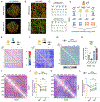Down-syndrome-induced senescence disrupts the nuclear architecture of neural progenitors
- PMID: 34995493
- PMCID: PMC8805993
- DOI: 10.1016/j.stem.2021.12.002
Down-syndrome-induced senescence disrupts the nuclear architecture of neural progenitors
Abstract
Down syndrome (DS) is a genetic disorder driven by the triplication of chromosome 21 (T21) and characterized by a wide range of neurodevelopmental and physical disabilities. Transcriptomic analysis of tissue samples from individuals with DS has revealed that T21 induces a genome-wide transcriptional disruption. However, the consequences of T21 on the nuclear architecture and its interplay with the transcriptome remain unknown. In this study, we find that unlike human induced pluripotent stem cells (iPSCs), iPSC-derived neural progenitor cells (NPCs) exhibit genome-wide "chromosomal introversion," disruption of lamina-associated domains, and global chromatin accessibility changes in response to T21, consistent with the transcriptional and nuclear architecture changes characteristic of senescent cells. Treatment of T21-harboring NPCs with senolytic drugs alleviates the transcriptional, molecular, and cellular dysfunctions associated with DS. Our findings provide a mechanistic link between T21 and global transcriptional disruption and indicate that senescence-associated phenotypes may play a key role in the neurodevelopmental pathogenesis of DS.
Keywords: 3D-genome; ATAC-seq; Down syndrome; Hi-C; RNA-seq; aneuploidy; epigenome; lamina-associated domains (LADs); senescence; senolytic drugs; transcriptome.
Copyright © 2021 Elsevier Inc. All rights reserved.
Conflict of interest statement
Declaration of interests The authors declare no competing interests.
Figures







References
-
- Allis CD, and Jenuwein T (2016). The molecular hallmarks of epigenetic control. Nat Rev Genet 17, 487–500. - PubMed
Publication types
MeSH terms
Grants and funding
LinkOut - more resources
Full Text Sources
Medical
Molecular Biology Databases
Research Materials

